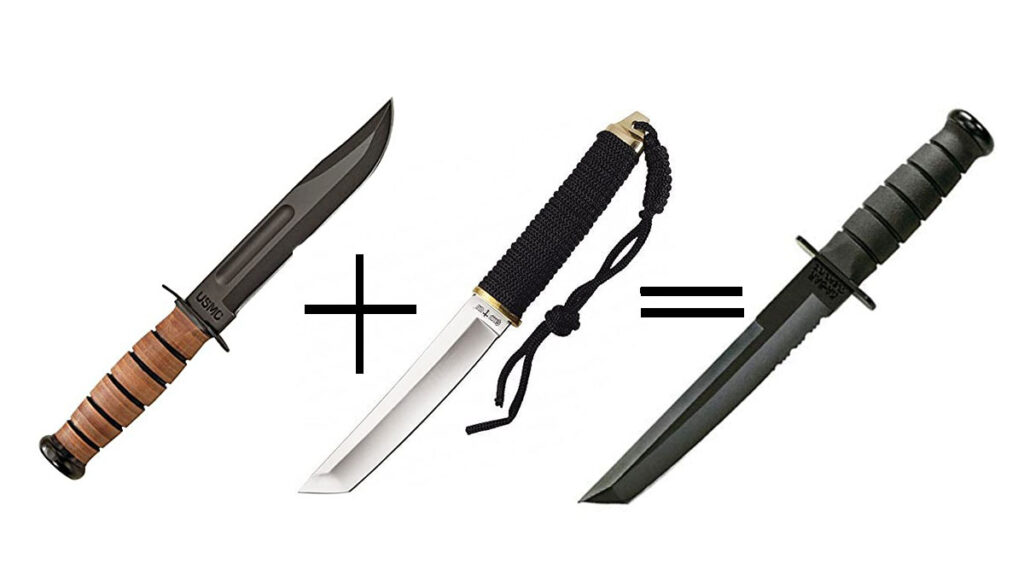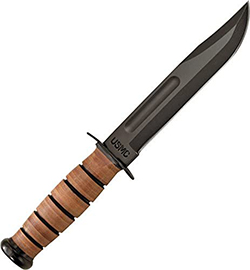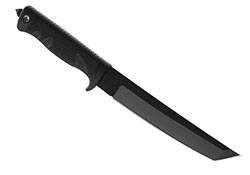
What would you get if you combined Kill Bills’ infamous Hattori Hanzo and Sylvester Stallone’s blade from Rambo? A Ka-Bar Tanto knife. The Kabar Tanto is a masterful blend of two lethal knives from two different parts of the world. It has earned a rightful spot into the Knife Hall of Fame because of its design cues taken from American Ka-Bar knife and the Tanto knife from Japan.
Each of these knives has been used for generations and has become the pet knife for everyone from hunters to sneaky street thugs to US army men to Japanese warriors. Now let’s cut through the chase and take a brief look into the history and workings of these two legendary knives and their merger into the Ka-Bar Tanto.
A Brief History of the Ka-Bar Knife

The Ka-Bar knife is the contemporary name for the combat knife first adopted by the United States Marine Corps dating back to 1942 as their combat knife of choice and afterward adopted as the U.S. Navy utility knife. During World War II, the U.S. Marine Corps wanted something sharp to aid their entry into enemy territories by crawling into trenches and fighting other troops.
After several failed designs, the Marine Corps manufactured the Ka-Bar knife that was officially used by the US Navy during the war, and became the official combat knife of the Unites States Navy Seals, too (see also the Buckmaster 184 story).
The success of this dual-purpose design (utility and knife-fighting) soon gained traction with not only other military organizations but also the American public. “Ka-Bar” soone became a household name. In addition to military contract knives, the knife enjoyed popularity as a go-to knife civilian purposes.
A Brief History of the Tanto Knife
The super-hyped style of the Japanese knife dates back to the Samurai Era. The Tanto holds an important place in Japanese culture. Ancient texts have several mentions of it throughout Japanese history. The Tanto is often identified for its distinct tip.
It was first used to deal with the armor of warriors on the field. Its sharp edge and ability to pierce made it a welcome addition to the fighter’s set of tools. Soon it became a staple weapon for the Japanese in war. The Tanto blade can be found in Japanese depictions of the same in Samurai arts showing warriors using it during warfare. There is an immense amount of culture, history, and heritage attached to this blade.
It has been adapted from the Samurai style swords and carries a similar design and shape. It also finds its mention in Japanese Martial arts. Tanto knives are used in various fighting styles, such as Kempo, ninjutsu, aikido, jujitsu, and others.
It was also used by Samurai men to commit ritual suicide (seppuku). From the intricate folding and forging process to the differential heat treating to the meticulous polishing that reveals both the beauty of the steel and highlights its deadly edge, this blade has made its mark in history and lives on today. The Tanto is a work of art.
Due to the style and making of the Japanese Tanto knife, not to mention the influx of American adapted Japanese films, it has attracted a lot of attention to the American market.
Ka-Bar + Tanto = Ka-Bar Tanto
The Ka-Bar Tanto knife is a interesting fusion between these two historic knives of the United States and ancient Japan. Right from the World War II era to the Japanese Samurai culture, both of these knives have played a significant role in their respective countries. The legend around each of them has grown for decades.
The American knife industry thought of capitalizing on this fame and thought of making a knife that is a mix of the Ka-Bar of the USA and the Tanto Knife of Japan. This gave birth to the KaBar Tanto knife! Really, it was only a matter of time before knife makers constructed a hybrid. And here we are.
As mentioned, the Ka-Bar Tanto consists of the best combination of qualities taken from both knives. Each of them has special features that contrast and complement each other.
The features of the Kabar knife are as follows:

#1 The Ka-Bar has a sturdy nature that has seen successful use by the US Marine Corps in cutting through trenches, fighting enemies, and general combat.
#2 The Ka-Bar has a proven history in warfare, self-defense, bushcraft, and as an all-around combat knife. It is accompanied by a well-recognized leather washer handle.
#3 The basic design of the Ka-Bar knife was 7-18 inches long with a fully sharpened 2.25-inch edge that makes for very handy use.
The features of the Tanto knife are as follows:
#1 The Tanto has a unique shape and sharpness taken from a Samurai Sword and converted into a blade that made it extremely handy in piercing into hard materials and cutting across any surface. Due to this, the knife enjoyed popularity as a go-to knife for collectors and general utilitarian purposes.

#2 Originally designed for armour piercing, the Tanto blade was carried by Cold Steel and is similar in style to Japanese short swords.
#3 The Tanto has been designed as a specialty knife used to pierce into hard materials such as wood and metal. The blade runs up to 8 inches long. However, the knife’s overall length is typically 12.8 inches. The Tanto’s steel is an impressive carbon-based 1095 Cro-Van, and its handle is the making of the popular rubber substitute Kraton- G. The overall weight of the knife is 0.70 lb.
Combined Features of the Ka-Bar Tanto
Now that we understand the history and usage of the Ka-Bar and Tanto knives, let us understand the technicalities that make them so hyped and special.
The American knife industry soon saw an opportunity to capitalize on the American Marine Corps toughness and the elegance of the Japanese Samurai style and produced a one-stop utility product for knife users. The Ka-Bar Tanto combines the best qualities of both knives.
Shape and Style: The Tanto style blade is strong. It is a full tang blade, meaning the blade continues into the handle as one piece of metal, making it a strong blade. This is not a knife for someone looking for a handy and compact knife. A lock knife is a more ideal knife for that.
Dimensions: When it comes to knives, size does matter. The overall length of the knife is 12.8 inches. The blade is in itself 8 inches long and 0.165’’ thick. It weighs just 0.7 pounds.
The steel of the knife has been designed in a way that it is easy to sharpen and maintain strength. It has been designed to last long and remain durable.
It would be safe to say that the Ka-Bar Tanto is an interesting blade for both preppers and collectors. The relatively inexpensive cost makes the Ka-Bar-Tanto knife a worthy purchase!

2 comments
Got one. I’ve had it for years on my GHB. Awesome knife!
The “Tanto” part of the article was confusing. I wasn’t sure if you were talking about Tanto knives in general or a specific model sold by Cold Steel, who by the way carry several Tanto blades and there is no specific set of dimensions for them. Even the katanas and wakizashis were not all identical as variations existed.
The Cold Steel Recon Tanto would be a good example of a modernized version, but they do have more classic designs as do other companies.
Overall I like the article for covering this particular Ka-Bar variant. I don’t really think the tip style matter that much and people have used both the Cold Steel SRK and Recon Tanto for bushcraft and there is no reason not to think the SRK couldn’t work as a defensive knife. So many have put down the Ka-Bar, but it was good for it’s intended purpose and still serves many as a good outdoor camp or survival knife. The variants prove people still love the knife over all and it still continues to create a legacy and memories for many.